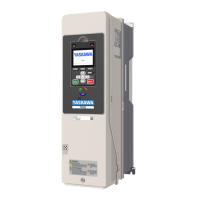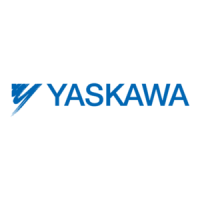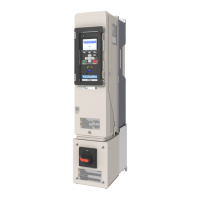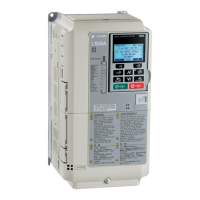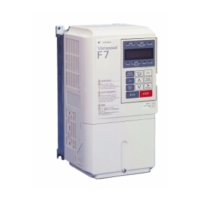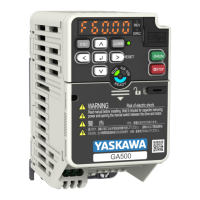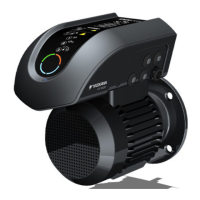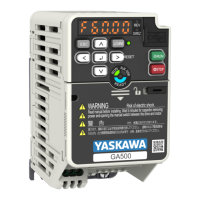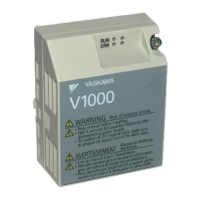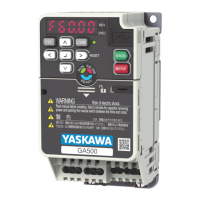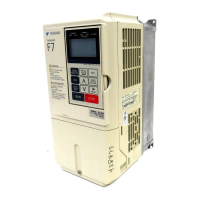
Do you have a question about the YASKAWA F7 and is the answer not in the manual?
| Series | F7 |
|---|---|
| Type | DC Drive |
| Feedback | Tachometer, Encoder |
| Communication | RS-485, DeviceNet, Profibus, Modbus |
| Protection Features | Overcurrent, Overvoltage, Undervoltage, Overheating, Short Circuit |
| Storage Temperature | -20°C to +70°C (-4°F to 158°F) |
| Humidity | 95% RH or less (non-condensing) |
| Enclosure Rating | IP20 |
| Input Voltage | 200-240V AC, 380-480V AC |
Describes the intended applications and standards conformity for the Drive in the European Union.
Lists the electrical specifications for the 208-240Vac range of F7 drives, including capacities and frequencies.
Lists the electrical specifications for the 480Vac range of F7 drives, including capacities and frequencies.
Details the model numbers, enclosure types, weight, and heat loss for various F7 drives.
Outlines essential checks to perform immediately after receiving the F7 Drive to ensure it is undamaged and correct.
Provides detailed external dimensions and mounting hole information for F7 drives across different voltage and model series.
Specifies environmental conditions, precautions, and optimal locations for installing the F7 Drive.
Details the required vertical installation orientation and minimum clearances around the Drive for proper cooling and airflow.
Provides step-by-step instructions for safely removing and reattaching the terminal cover for cable connections.
Explains the procedures for safely detaching and reattaching the digital operator and front cover.
Illustrates the terminal layout and configurations for different F7 Drive models, including main and control circuits.
Details the applicable wire sizes and connector specifications for connecting main circuit terminals based on drive model and voltage.
Describes the functions and signal levels of various control circuit terminals for 2-wire and 3-wire control.
Outlines measures for complying with EMC directives, including cable installation and grounding guidelines.
Lists available option boards, their specifications, and mounting locations within the Drive.
Explains the purpose and installation of dynamic braking options, including resistor units and transistors.
Describes the various elements and information displayed on the Digital Operator, including indicators and data displays.
Explains the names and functions of each key on the Digital Operator for navigation and control.
Outlines the five primary menus available on the Drive for programming, operation, and monitoring.
Details the parameters accessible through the Quick Setting menu, used for commonly adjusted drive settings.
Describes the Programming Menu, which allows access to all drive parameters and copying functions.
Provides a step-by-step guide on how to modify a drive parameter using the Digital Operator.
Lists essential pre-start-up checks and information required to ensure a reliable and proper installation of the Drive.
Outlines the general steps for applying power and verifying basic Drive setup.
Details the specific procedures for setting up the Drive using the V/F control method.
Details the steps for configuring and starting the Drive with the Flux Vector control method.
Explains the importance and methods of Auto-Tuning to optimize motor performance and determine key motor characteristics.
Explains how parameter tables are organized, including control method availability and setting details.
Describes how to select the appropriate control method (V/F, V/F w/PG, Open Loop Vector, Flux Vector) for the Drive application.
Details how to select the input source for speed commands, such as operator, terminals, serial communication, or option board.
Explains how to select the input source for run commands, including operator keys, terminals (2-wire/3-wire), serial communication, and option boards.
Describes the four available methods for stopping the Drive when the run command is removed.
Explains how to set acceleration and deceleration times, including alternate settings activated by multi-function inputs.
Details how to select the carrier frequency to reduce audible noise and leakage current, with considerations for wiring length and duty selection.
Details parameters for setting motor characteristics like rated current, poles, resistance, and inductance, crucial for Vector control and Auto-Tuning.
Explains the Drive's electronic overload protection (OL1) function and how to select curves based on motor cooling type.
Details the stall prevention functions during acceleration, deceleration, and running to prevent OV faults and motor issues.
Provides a table of fault displays, their causes, and corrective actions to help diagnose and resolve Drive issues.
Lists common alarm displays, their causes, and corrective actions, which do not activate the fault contact but require attention.
Offers guidance on resolving issues where the Drive or motor does not operate as expected, covering parameter setting errors and wiring problems.
Outlines essential checks to perform on the Drive and motor during periodic maintenance, both with and without power applied.
Details the procedures for safely removing and installing heatsink cooling fans for specific F7 Drive models.
A comprehensive list of all F7 Drive parameters, including their numbers, Digital Operator display names, descriptions, and control method availability.
Lists all monitor parameters available on the Digital Operator, their display units, and descriptions.
Details parameters related to fault tracing, providing information about conditions at the time of a fault.
Explains how parameter o2-04 sets the Drive capacity based on model number, which affects other parameter defaults.
Provides detailed electrical specifications for the 208-240Vac range of F7 Drives, including output ratings and power supply characteristics.
Details the electrical specifications for the 480Vac range of F7 Drives, covering output ratings and power supply characteristics.
Lists common specifications applicable to both 200Vac and 400Vac class F7 Drives, covering various operational and protective functions.
Explains how to perform serial communication using Modbus protocol with PLCs or master devices.
Explains the function codes used in Modbus communication, detailing message formats for reading and writing registers.
Provides tables for Modbus reference data, monitor data, broadcast data, and enter commands, essential for communication setup.
Recommends fuses and circuit breakers required for branch circuit protection, referencing NEC codes and UL designations.
States that built-in motor overload protection is provided and additional branch circuit protection is not required for single motor applications.
Lists primary spare parts for 208-240Vac F7 Drive models, detailing components for various PCBs.
Lists primary spare parts for 480Vac F7 Drive models, specifying components for different PCBs.
